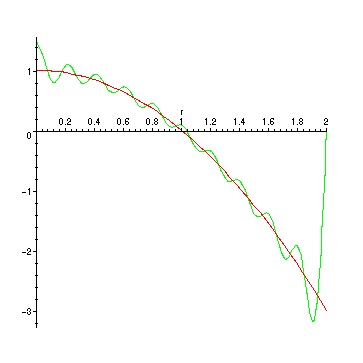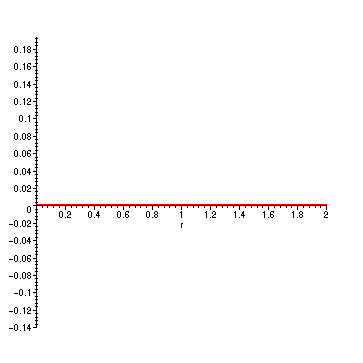![[Maple Math]](images/BesselDemos1.gif)
Mathematics 174 -- Applied Mathematics 2
February 17 - 19, 2000
Bessel Functions and The Vibrating Circular Drumhead
> read "/home/fac/little/public_html/Applied9900/BesselData.m";
Part 1: Eigenfunctions and Eigenvalues for the BVP
![[Maple Math]](images/BesselDemos1.gif)
![]()
![]()
> f := BesselJ(m,BesselJZeros(m,n)*r/a);
![]()
> simplify(diff(r*diff(f,r),r) - m^2*f/r);
![[Maple Math]](images/BesselDemos5.gif)
Note: This says that
f
is an eigenfunction of
![[Maple Math]](images/BesselDemos6.gif)
with eigenvalue
![[Maple Math]](images/BesselDemos7.gif) and weight function
and weight function
![]() .
.
Here are some plots. We fix m = 3, a = 2, and let n vary.
> phi := n -> BesselJ(3,BesselJZeros(3,n)*r/2);
![]()
> plot({phi(1),phi(2),phi(3),phi(4)},r = 0..2);

Note that the same patterns of zeros that we know for eigenfunctions of regular Sturm-Liouville problems
are also true here!
Part 2: Fourier - Bessel Series
Given any piecewise smooth function
![]() on
[0,a],
and given any particular
on
[0,a],
and given any particular
nonnegative integer
m,
we can expand
![]() in a
Fourier-Bessel series
:
in a
Fourier-Bessel series
:
![[Maple Math]](images/BesselDemos13.gif)
using the eigenfunctions
![[Maple Math]](images/BesselDemos14.gif) , where
, where
![]() are the
are the
positive roots of
![]() , and the Fourier-Bessel coefficients are given by
, and the Fourier-Bessel coefficients are given by
![[Maple Math]](images/BesselDemos17.gif)
There is a point-wise convergence theorem valid here too, just as for the eigenfunction
expansions for regular Sturm-Liouville problems.
For instance, let's consider
![]() with
a = 2,
and
m = 0.
(These are chosen
with
a = 2,
and
m = 0.
(These are chosen
arbitrarily -- as we will see in later examples, the value of m that must be used is
often determined by other conditions in actual problems.)
> with(plots):
> psi := r -> 1 - r^2;
![]()
> phi := n -> BesselJ(0,BesselJZeros(0,n)*r/2);
![]()
The Fourier-Bessel coefficients are given by the formula above, with m = 0:
> a := n -> evalf(Int(psi(r)*phi(n)*r,r = 0 .. 2))/evalf(Int(phi(n)^2*r,r = 0 .. 2));
![[Maple Math]](images/BesselDemos21.gif)
As always, to plot, we need to look at partial sums of the Fourier-Bessel series:
> PS := N -> add(a(n)*phi(n),n=1..N);
Warning, `n` in call to `add` is not local
![]()
> FBPlot:=plot({psi(r),PS(20)},r=0..2):
> display(FBPlot);

Note: Because all the eigenfunctions have the value zero at r = 2, there will be jump
(Gibbs phenomenon-like) effects there. A similar phenomenon is happening at r = 0.
For each fixed
r
in
(0,2),
since this
![]() is continuous on the open interval,
is continuous on the open interval,
the Fourier-Bessel series will converge to
![]() . However, the over- and under-shoots
. However, the over- and under-shoots
at the endpoints for the partial sums will persist (but get closer to the ends and "thinner")
no matter how large N is.
Part 3: The Vibrating Circular Drumhead
For the boundary value problem:
![]()
![]()
![]()
![]()
we use Fourier-Bessel expansions as above to find the solution. Since the initial data
is independent of
![]() , only the terms with
m = 0
in our general expansions are
, only the terms with
m = 0
in our general expansions are
needed:
> beta := piecewise(r < .25,-1,0):
> phi := n -> BesselJ(0,BesselJZeros(0,n)*r/2);
![]()
The Fourier-Bessel coefficients are given by the formula above
> A := n -> (2/BesselJZeros(0,n)*1)*evalf(Int(beta(r)*phi(n)*r,r = 0 .. 2))/evalf(Int(phi(n)^2*r,r = 0 .. 2));
![[Maple Math]](images/BesselDemos32.gif)
As always, to plot, we need to look at partial sums of the Fourier-Bessel series:
> PSu := add(A(n)*phi(n)*sin(BesselJZeros(0,n)*1*t/2),n=1..5):
> animate(PSu,r=0..2,t=0..10,frames=50);

> save FBPlot,PSu,"/home/fac/little/public_html/Applied9900/BesselData.m";
>